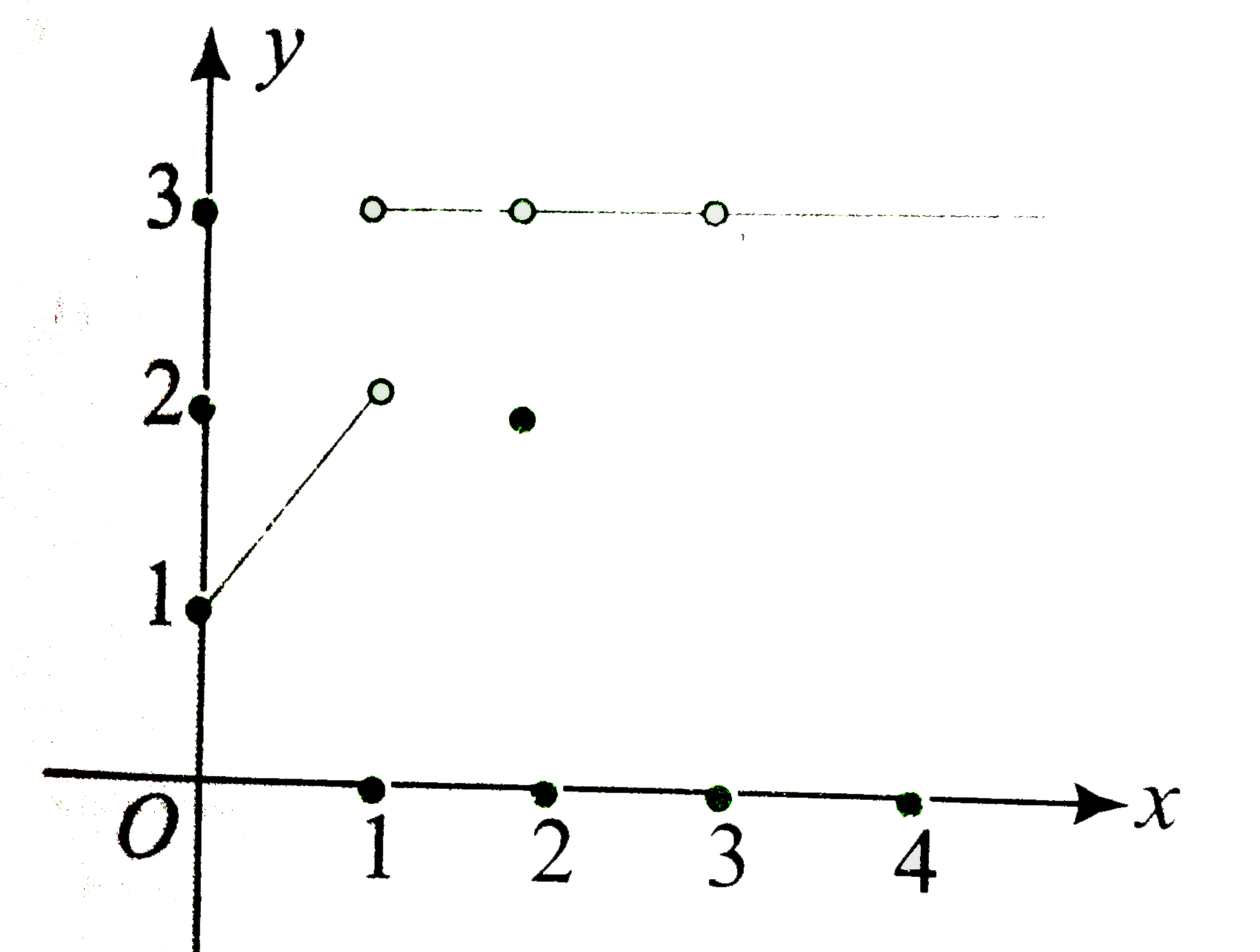Consider the following graph of the function y=f(x). Which of the following is/are correct? fig. 1. (lim)x→1f(x) does not exist. 2.(lim)x→2f(x) does not exist. 3. (lim)x→3f(x)=3. 4. (lim)x−−→1.99f(x)= exists
To solve the problem, we need to analyze the limits of the function f(x) at specific points given the graph of the function. We will evaluate each option step by step.
Step 1: Evaluate limx→1f(x)
1. Right-hand limit: limx→1+f(x)
- As x approaches 1 from the right, f(x) approaches 3.
- Thus, limx→1+f(x)=3.
2. Left-hand limit: limx→1−f(x)
- As x approaches 1 from the left, f(x) approaches 2.
- Thus, limx→1−f(x)=2.
3. Conclusion: Since limx→1+f(x)≠limx→1−f(x), the limit does not exist.
- Therefore, Option 1 is correct: limx→1f(x) does not exist.
Step 2: Evaluate limx→2f(x)
1. Right-hand limit: limx→2+f(x)
- As x approaches 2 from the right, f(x) approaches 3.
- Thus, limx→2+f(x)=3.
2. Left-hand limit: limx→2−f(x)
- As x approaches 2 from the left, f(x) also approaches 3.
- Thus, limx→2−f(x)=3.
3. Conclusion: Since limx→2+f(x)=limx→2−f(x)=3, the limit exists.
- Therefore, Option 2 is incorrect: limx→2f(x) does exist.
Step 3: Evaluate limx→3f(x)
1. Right-hand limit: limx→3+f(x)
- As x approaches 3 from the right, f(x) approaches 3.
- Thus, limx→3+f(x)=3.
2. Left-hand limit: limx→3−f(x)
- As x approaches 3 from the left, f(x) also approaches 3.
- Thus, limx→3−f(x)=3.
3. Conclusion: Since limx→3+f(x)=limx→3−f(x)=3, the limit exists.
- Therefore, Option 3 is correct: limx→3f(x)=3.
Step 4: Evaluate limx→1.99f(x)
1. Right-hand limit: limx→1.99+f(x)
- As x approaches 1.99 from the right, f(x) approaches 2.
- Thus, limx→1.99+f(x)=2.
2. Left-hand limit: limx→1.99−f(x)
- As x approaches 1.99 from the left, f(x) also approaches 2.
- Thus, limx→1.99−f(x)=2.
3. Conclusion: Since limx→1.99+f(x)=limx→1.99−f(x)=2, the limit exists.
- Therefore, Option 4 is correct: limx→1.99f(x) exists.
Summary of Results:
- Option 1: Correct (limit does not exist)
- Option 2: Incorrect (limit exists)
- Option 3: Correct (limit equals 3)
- Option 4: Correct (limit exists)
- As x approaches 1 from the right, f(x) approaches 3.
- Thus, limx→1+f(x)=3.
- As x approaches 1 from the left, f(x) approaches 2.
- Thus, limx→1−f(x)=2.
- Therefore, Option 1 is correct: limx→1f(x) does not exist.
- As x approaches 2 from the right, f(x) approaches 3.
- Thus, limx→2+f(x)=3.
- As x approaches 2 from the left, f(x) also approaches 3.
- Thus, limx→2−f(x)=3.
- Therefore, Option 2 is incorrect: limx→2f(x) does exist.
- As x approaches 3 from the right, f(x) approaches 3.
- Thus, limx→3+f(x)=3.
- As x approaches 3 from the left, f(x) also approaches 3.
- Thus, limx→3−f(x)=3.
- Therefore, Option 3 is correct: limx→3f(x)=3.
- As x approaches 1.99 from the right, f(x) approaches 2.
- Thus, limx→1.99+f(x)=2.
- As x approaches 1.99 from the left, f(x) also approaches 2.
- Thus, limx→1.99−f(x)=2.
- Therefore, Option 4 is correct: limx→1.99f(x) exists.
- Option 1: Correct (limit does not exist)
- Option 2: Incorrect (limit exists)
- Option 3: Correct (limit equals 3)
- Option 4: Correct (limit exists)
Topper's Solved these Questions
- DIFFERENT PRODUCTS OF VECTORS AND THEIR GEOMETRICAL APPLICATIONS BOOK - CENGAGE ENGLISHCHAPTER - DIFFERENT PRODUCTS OF VECTORS AND THEIR GEOMETRICAL APPLICATIONS EXERCISE - Multiple correct answers type
11 Videos
- LINEAR INEQUALITIESBOOK - CENGAGE ENGLISHCHAPTER - LINEAR INEQUALITIESEXERCISE - All Questions
68 Videos
Similar Questions
Consider the following graph of the function y=f(x). Which of the following is//are correct?

(a)limx→1f(x) does not exist.
(b)limx→2f(x) does not exist.
(c)limx→3f(x)=3.
(d)limx→1.99f(x)exists.
View SolutionIf f(x)=3x2+ax+a+1x2+x−2, then which of the following can be correct (lim)x→1f(x)eξstsa=−2 (lim)x→−2f(x)eξstsa=13 (lim)x→1f(x)=43 (lim)x→−2f(x)=−13
View SolutionIf f(x)=3x2+ax+a+1x2+x−2, then which of the following can be correct (a) (lim)x→1f(x)fora=−2 (b) (lim)x→−2f(x)fora=13 (c) (lim)x→1f(x)=43 (d) (lim)x→−2f(x)=−13
View SolutionWhich of the following limits tends to unity? (a)(lim)x→0sin(tanx)sinx (b) (lim)x→π2sin(cosx)cosx (c) (lim)x→0sinex−1x (d) (lim)x→0√1+x−√1−xx
View Solution(lim)x→1(1−x)tan(πx)2=___
View SolutionIf (lim)x→a[f(x)g(x)] exists, then both (lim)x→af(x)and(lim)x→ag(x) exist.
View SolutionIf (lim)x→a[f(x)g(x)] exists, then both (lim)x→af(x)and(lim)x→ag(x) exist.
View SolutionWhich of the following is and determinate form (lim)x→1x3−1x−1 b. (lim)x→0(1+x)1/x c. (lim)x→1(1x2−1−1x−1) d. (lim)x→0(|x|)s∈R
View SolutionIf f(x)=|x|x, then show that limx→0f(x) does not exist.
View SolutionIf f(x)=|x−a|x−a, then show that limx→af(x) does not exist.
View Solution
